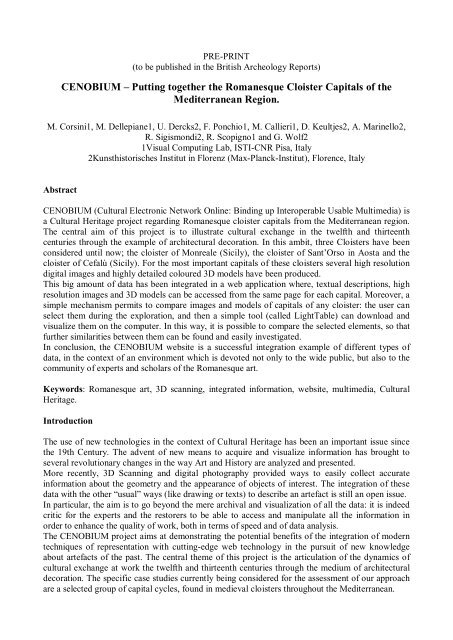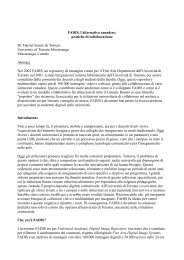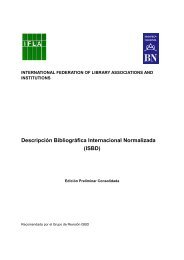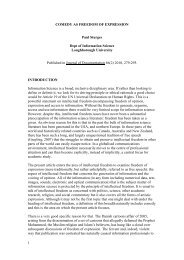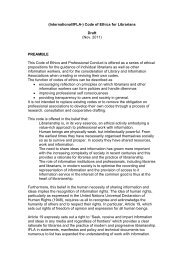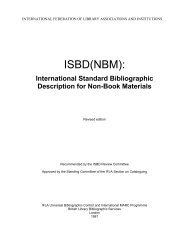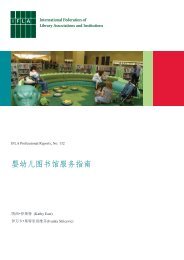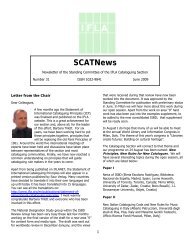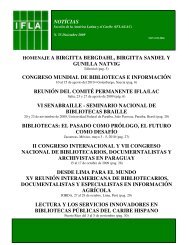CENOBIUM â Putting together the Romanesque Cloister ... - IFLA
CENOBIUM â Putting together the Romanesque Cloister ... - IFLA
CENOBIUM â Putting together the Romanesque Cloister ... - IFLA
You also want an ePaper? Increase the reach of your titles
YUMPU automatically turns print PDFs into web optimized ePapers that Google loves.
PRE-PRINT<br />
(to be published in <strong>the</strong> British Archeology Reports)<br />
<strong>CENOBIUM</strong> – <strong>Putting</strong> <strong>toge<strong>the</strong>r</strong> <strong>the</strong> <strong>Romanesque</strong> <strong>Cloister</strong> Capitals of <strong>the</strong><br />
Mediterranean Region.<br />
M. Corsini1, M. Dellepiane1, U. Dercks2, F. Ponchio1, M. Callieri1, D. Keultjes2, A. Marinello2,<br />
R. Sigismondi2, R. Scopigno1 and G. Wolf2<br />
1Visual Computing Lab, ISTI-CNR Pisa, Italy<br />
2Kunsthistorisches Institut in Florenz (Max-Planck-Institut), Florence, Italy<br />
Abstract<br />
<strong>CENOBIUM</strong> (Cultural Electronic Network Online: Binding up Interoperable Usable Multimedia) is<br />
a Cultural Heritage project regarding <strong>Romanesque</strong> cloister capitals from <strong>the</strong> Mediterranean region.<br />
The central aim of this project is to illustrate cultural exchange in <strong>the</strong> twelfth and thirteenth<br />
centuries through <strong>the</strong> example of architectural decoration. In this ambit, three <strong>Cloister</strong>s have been<br />
considered until now; <strong>the</strong> cloister of Monreale (Sicily), <strong>the</strong> cloister of Sant’Orso in Aosta and <strong>the</strong><br />
cloister of Cefalù (Sicily). For <strong>the</strong> most important capitals of <strong>the</strong>se cloisters several high resolution<br />
digital images and highly detailed coloured 3D models have been produced.<br />
This big amount of data has been integrated in a web application where, textual descriptions, high<br />
resolution images and 3D models can be accessed from <strong>the</strong> same page for each capital. Moreover, a<br />
simple mechanism permits to compare images and models of capitals of any cloister: <strong>the</strong> user can<br />
select <strong>the</strong>m during <strong>the</strong> exploration, and <strong>the</strong>n a simple tool (called LightTable) can download and<br />
visualize <strong>the</strong>m on <strong>the</strong> computer. In this way, it is possible to compare <strong>the</strong> selected elements, so that<br />
fur<strong>the</strong>r similarities between <strong>the</strong>m can be found and easily investigated.<br />
In conclusion, <strong>the</strong> <strong>CENOBIUM</strong> website is a successful integration example of different types of<br />
data, in <strong>the</strong> context of an environment which is devoted not only to <strong>the</strong> wide public, but also to <strong>the</strong><br />
community of experts and scholars of <strong>the</strong> <strong>Romanesque</strong> art.<br />
Keywords: <strong>Romanesque</strong> art, 3D scanning, integrated information, website, multimedia, Cultural<br />
Heritage.<br />
Introduction<br />
The use of new technologies in <strong>the</strong> context of Cultural Heritage has been an important issue since<br />
<strong>the</strong> 19th Century. The advent of new means to acquire and visualize information has brought to<br />
several revolutionary changes in <strong>the</strong> way Art and History are analyzed and presented.<br />
More recently, 3D Scanning and digital photography provided ways to easily collect accurate<br />
information about <strong>the</strong> geometry and <strong>the</strong> appearance of objects of interest. The integration of <strong>the</strong>se<br />
data with <strong>the</strong> o<strong>the</strong>r “usual” ways (like drawing or texts) to describe an artefact is still an open issue.<br />
In particular, <strong>the</strong> aim is to go beyond <strong>the</strong> mere archival and visualization of all <strong>the</strong> data: it is indeed<br />
critic for <strong>the</strong> experts and <strong>the</strong> restorers to be able to access and manipulate all <strong>the</strong> information in<br />
order to enhance <strong>the</strong> quality of work, both in terms of speed and of data analysis.<br />
The <strong>CENOBIUM</strong> project aims at demonstrating <strong>the</strong> potential benefits of <strong>the</strong> integration of modern<br />
techniques of representation with cutting-edge web technology in <strong>the</strong> pursuit of new knowledge<br />
about artefacts of <strong>the</strong> past. The central <strong>the</strong>me of this project is <strong>the</strong> articulation of <strong>the</strong> dynamics of<br />
cultural exchange at work <strong>the</strong> twelfth and thirteenth centuries through <strong>the</strong> medium of architectural<br />
decoration. The specific case studies currently being considered for <strong>the</strong> assessment of our approach<br />
are a selected group of capital cycles, found in medieval cloisters throughout <strong>the</strong> Mediterranean.
<strong>CENOBIUM</strong> provides a web-based open-access research environment, which includes 3D models<br />
created by combining high-resolution scanning with on-site digital photographic campaigns of <strong>the</strong><br />
highest professional quality. The technical tools dedicated to <strong>the</strong> integration and extension of<br />
available technologies include databases, image-viewers, 3D-viewers, content management, and <strong>the</strong><br />
innovative LightTable tool (described in <strong>the</strong> next), as well as o<strong>the</strong>r digital tools and media.<br />
Cenobium offers <strong>the</strong> user <strong>the</strong> opportunity to fully manipulate <strong>the</strong> 3D images of <strong>the</strong> capitals in order<br />
to allow for maximum visual clarity from any point of view, including high-resolution zoom<br />
capability. This allows convenient and interactive access to <strong>the</strong> formal, narrative, and material<br />
contents of <strong>the</strong> capitals that can exceed even on-site study of <strong>the</strong> cloister. This will provide for more<br />
comprehensive appreciation, documentation, and interpretation of <strong>the</strong> site by allowing <strong>the</strong> user to<br />
virtually move inside <strong>the</strong> cloister itself, to focus in on a particular capital, and to analyze and<br />
compare capitals from different cloisters at <strong>the</strong> same time on <strong>the</strong> same screen. By means of<br />
innovative technological solutions, all data (at <strong>the</strong> highest level of detail and resolution) will be<br />
accessible at a dedicated kiosk installation in <strong>the</strong> institute, locally on private computers, and from<br />
anywhere on <strong>the</strong> World Wide Web. One of <strong>the</strong> main components of this innovative solution is <strong>the</strong><br />
LightTable tool. This works as a shopping cart in an e-commerce website; <strong>the</strong> users select items<br />
during <strong>the</strong> navigation in <strong>the</strong> website, but <strong>the</strong>y can compare <strong>the</strong>m instead of buying such items.<br />
Specifically, <strong>the</strong> high-res photos and <strong>the</strong> geometry of <strong>the</strong> capitals can be selected.<br />
In this paper we will describe <strong>the</strong> steps which brought to <strong>the</strong> creation of <strong>the</strong> prototype of this<br />
integrated environment, which was made available online at <strong>the</strong> address http://cenobium.isti.cnr.it/ .<br />
First, we will present <strong>the</strong> motivations which led to choice of <strong>the</strong> <strong>Romanesque</strong> cloisters around<br />
Europe as a large and promising test case. Then, we will shortly describe <strong>the</strong> technologies used to<br />
acquire and process <strong>the</strong> data which are present inside <strong>the</strong> collaborative environment. In particular,<br />
<strong>the</strong> pipeline and <strong>the</strong> tools used to produce <strong>the</strong> accurate coloured 3D models of <strong>the</strong> capitals will be<br />
presented. The Section about <strong>the</strong> website will show how all <strong>the</strong> data were integrated in <strong>the</strong> context<br />
of <strong>the</strong> developed web application, with particular attention to <strong>the</strong> mechanism which helps <strong>the</strong> user<br />
in comparing <strong>the</strong> data from different cloisters around Italy. Finally, <strong>the</strong> discussion and <strong>the</strong><br />
conclusions will underline <strong>the</strong> achieved results and <strong>the</strong> future work.<br />
The <strong>Romanesque</strong> cloisters around Europe: a complex and promising test case<br />
The cloister of <strong>the</strong> Ca<strong>the</strong>dral of Monreale in Sicily was <strong>the</strong> starting point of <strong>the</strong> Cenobium project.<br />
Its high quality <strong>Romanesque</strong> sculptural programme is extremely well suited to <strong>the</strong> technological<br />
analysis. Executed between 1174 and 1189 under <strong>the</strong> patronage of King William II, this cloister<br />
unites various artistic currents of <strong>Romanesque</strong> sculpture <strong>the</strong>n circulating in <strong>the</strong> Mediterranean into<br />
an architecturally homogeneous ensemble. Along with Monreale, <strong>the</strong> cloisters of Sant’Orso in<br />
Aosta (c. 1150) and Cefalù (c. 1131/1166 o 1185/1189), belong to <strong>the</strong> few cloisters in Italy that<br />
display an extensive capital programme comprising both narrative and figural representations. The<br />
cloister in Aosta, for example, stands as an exemplary monument of <strong>the</strong> artistic development of<br />
medieval capital design in <strong>the</strong> Mediterranean and, stylistically, constitutes a bridgehead between <strong>the</strong><br />
French and Italian cloister type.<br />
The Italian Medieval cloisters (Monreale, Cefalú, and Aosta) are only some of <strong>the</strong> examples of <strong>the</strong><br />
<strong>Romanesque</strong> art, which includes several contemporary Spanish and French examples.<br />
These cycles of historiated capitals integrate narrative elements into <strong>the</strong>ir particular physical<br />
contexts. The nature of this type of cloister design – with free-standing columns and a moving<br />
viewer - is particularly well suited to narratives that must be scene from all sides. Therefore, <strong>the</strong>y<br />
afford <strong>the</strong> possibility of telling stories through a series of relief compositions, while facilitating a<br />
dialogue among and between capitals and o<strong>the</strong>r decorative elements of <strong>the</strong> cloister. Of additional<br />
importance is <strong>the</strong> spatial interrelation between <strong>the</strong> capital and <strong>the</strong> functional design of <strong>the</strong> cloister<br />
complex. The arrangement of <strong>the</strong>mes and motifs on <strong>the</strong> capitals permits, in some cases, an aes<strong>the</strong>tic
and physical interaction on <strong>the</strong> part of <strong>the</strong> viewer and gives us an idea about <strong>the</strong> liturgical role and<br />
ritual practices associated with <strong>the</strong> cloister.<br />
Moreover, <strong>the</strong> similarities between capitals around Europe can bring to <strong>the</strong> discovering of points of<br />
contact between different sculpting schools, which can be consequence of a common way of<br />
thinking or of contacts and contaminations between <strong>the</strong> artists.<br />
Data collection and processing<br />
The comprehensive acquisition campaigns performed in Monreale, Aosta and Cefalù brought to <strong>the</strong><br />
creation of a large database of high quality 2D and 3D data. High-end devices were used for both<br />
image and geometry, as shown in <strong>the</strong> next subsections. Then <strong>the</strong> data were performed using various<br />
non-commercial tools, in order to produce extremely accurate colored 3D models.<br />
High resolution digital imaging<br />
A Sinar P3 digital camera was purchased by <strong>the</strong> Photo Library of <strong>the</strong> Kunsthistorisches Institut,<br />
providing for <strong>the</strong> integration of <strong>the</strong> digital backs Sinarback 54 H and Sinarback eMotion 22, both of<br />
<strong>the</strong>m with a resolution of 22 million pixels (sensor resolution 5440×4080 pixels), as well as various<br />
Sinaron lenses. This is a very expensive but also very high quality device, which can produce<br />
impressive results if used by a professional photographer.<br />
The high-resolution digital images are created in a two-step process. First, a digital image is<br />
produced with a color management tool by Gretagmacbeth, following <strong>the</strong> intent to save as much<br />
information as possible with <strong>the</strong> one-, four- or sixteen-shot (taken at different exposure levels). This<br />
master copy is used for producing fur<strong>the</strong>r copies and for long-term preservation. Its size ranges<br />
from approximately 130 up to 520 Megabytes (TIFF format uncompressed, 16-bit colour depth and<br />
300dpi). A working image copy is created from this master. This copy is digitally enhanced to<br />
allow improved quality on a low-dynamic range output device (screen or printing device). Its size is<br />
approximately 65 Megabytes (TIFF format uncompressed, 8-bit-per-channel colour depth, 4000 ×<br />
4000 pixels - approximately 33 cm on a 300 dpi printout).<br />
The photographic campaigns on <strong>the</strong> cloisters were performed by acquiring 8 images for <strong>the</strong> highly<br />
interesting capitals and 4 or less images for <strong>the</strong> low interest capitals. This brought to <strong>the</strong> acquisition<br />
of a total of ?? images for <strong>the</strong> Monreale cloister, ?? images for <strong>the</strong> Aosta cloister and ?? images for<br />
<strong>the</strong> Cefalù cloister.<br />
Geometry acquisition: scanning <strong>the</strong> capitals<br />
For two of <strong>the</strong> acquisition campaigns (Monreale and Cefalù), a Konica Minolta VI 910 Laser<br />
Scanner (a device based on optical triangulation) was used. Triangulation scanning permits to<br />
acquire accurately geometry of an object with a sampling density of around 10 samples/sq.mm. and<br />
a sampling error lower than 0.05 mm. Since <strong>the</strong> scanner works at a distance between 50 and 100 cm<br />
from <strong>the</strong> objects, it was necessary to put it on scaffolding. It is well known that scanning any 3D<br />
object requires <strong>the</strong> acquisition of many shots of <strong>the</strong> artefact, taken from different viewpoints, to<br />
ga<strong>the</strong>r geometry information on all of its shape. Therefore, to perform a complete acquisition<br />
several range maps were needed; <strong>the</strong> number of range maps requested depends on <strong>the</strong> surface extent<br />
of <strong>the</strong> object and on its shape complexity. A number from 120 to 200 single scans (each scan<br />
samples around 0.3 Million points of <strong>the</strong> surface) was needed to cover <strong>the</strong> entire surface of each<br />
Monreale capital. In <strong>the</strong> case of Cefalù capitals, due to <strong>the</strong>ir smaller size and more simple geometry,<br />
a number from 50 to 80 was necessary. The Monreale scanning campaign (February 2006) brought<br />
to <strong>the</strong> acquisition of 20 out of <strong>the</strong> more than 100 capitals of <strong>the</strong> cloister (Baracchini et al, 2006),<br />
with a total of nearly 4000 range maps. The Cefalù scanning campaign produced ten 3D models,<br />
with a total of nearly 800 range maps.
The acquisition of <strong>the</strong> geometry of <strong>the</strong> Aosta cloister capitals was performed by ITABC-CNR of<br />
Rome using a Menci ZScan, which employs images taken from calibrated images to produce<br />
accurate range maps. This technology heavily relies on Computer Vision techniques for 3D<br />
reconstruction from images. The main difference with <strong>the</strong> Minolta device is <strong>the</strong> final accuracy of<br />
<strong>the</strong> geometry that is slightly lower. Moreover, <strong>the</strong> numbers of samples are hundreds of thousands<br />
instead of millions. Using this technology, eighteen 3D models were produced, starting from 24<br />
range maps for each capital.<br />
The range maps from both Minolta and Menci ZScan devices were processed to convert it into a<br />
single, complete and non-redundant 3D representation. The processing steps followed <strong>the</strong> usual 3D<br />
scanning pipeline (Bernardini and Rushmeier, 2002):<br />
• range maps alignment;<br />
• range maps merging (or fusion), to build a single, non redundant mesh out of <strong>the</strong><br />
many, partially overlapping range maps;<br />
• mesh editing, to improve (if possible) <strong>the</strong> quality of <strong>the</strong> reconstructed mesh;<br />
• mesh simplification and conversion into a multiresolution representation;<br />
• color mapping (see next Subsection).<br />
This processing steps was obtained through <strong>the</strong> ISTI-CNR tools, which give <strong>the</strong> possibility to deal<br />
with large number of range maps and to produce <strong>the</strong> final model with <strong>the</strong> lowest possible human<br />
intervention. A complete overview of <strong>the</strong>se tools is presented in (Callieri et al., 2003).<br />
The number of triangles of each model ranges from 4 to 6 millions, depending on <strong>the</strong> shape<br />
complexity and size of each capital.<br />
Adding color to <strong>the</strong> 3D geometry<br />
As already mentioned in <strong>the</strong> previous subsection, color mapping is an important step in <strong>the</strong><br />
scanning pipeline. As a result of <strong>the</strong> acquisition campaigns we had high quality 2D and 3D<br />
information: <strong>the</strong> objective was to integrate <strong>the</strong>m in a unique model, preserving <strong>the</strong> detail of both<br />
color and geometry. In order to produce a detailed colored model starting from <strong>the</strong> set of photos<br />
provided, two phases are necessary:<br />
• each photo has to be “aligned” to <strong>the</strong> model: <strong>the</strong> extrinsic (position in <strong>the</strong> space) and<br />
intrinsic (focal length and lens distortion) parameters of <strong>the</strong> camera which took <strong>the</strong> photo<br />
were estimated with an appropriate tool (Franken et al., 2005);<br />
• due to <strong>the</strong> highly detailed geometry, we chose to represent color following a per-vertex<br />
approach: for each vertex, <strong>the</strong> color assigned is computed as a weighted sum of <strong>the</strong><br />
contributions of every photo which framed that vertex (Callieri et al., 2008a).<br />
Following this approach, we produced a set of high detailed colored models (see Figure 2). The<br />
union of 2D and 3D information can lead to a new way to archive and remotely represent Cultural<br />
Heritage objects.<br />
In <strong>the</strong> next Section, which describes <strong>the</strong> <strong>CENOBIUM</strong> website, we describe how this data are<br />
integrated in <strong>the</strong> web application.<br />
The <strong>CENOBIUM</strong> website<br />
Nowadays, several digital instruments to archive and analyze <strong>the</strong> data about artefacts of interest in<br />
<strong>the</strong> ambit of Cultural Heritage are available. As previously stated, one of <strong>the</strong> main problem is <strong>the</strong><br />
integration of all of such data in a useful manner. Obviously, <strong>the</strong> integrated information system can
e designed for specific purposes, following <strong>the</strong> requirements of certain kind of users (e.g.<br />
hobbyists, tourists, experts or researchers).<br />
Previous approaches in <strong>the</strong> presentation of multimodal data (Balzani et al., 2004; Baracchini et al,<br />
2004) were mainly devoted to <strong>the</strong> integration of 3D models with textual information. These<br />
environments were created to provide an easily navigable environment for naïve users.<br />
The Cenobium web application tries to be an integrated environment for several categories of users.<br />
For example, naive users can simply read information about <strong>the</strong> capitals, analyse <strong>the</strong> high-resolution<br />
images and navigate <strong>the</strong> 3D models (Callieri et al., 2008b).. At <strong>the</strong> same time, experts and academic<br />
researchers can exploit all <strong>the</strong> potential of this environment in order to make fur<strong>the</strong>r studies about<br />
<strong>the</strong> capitals.<br />
The current web application includes two <strong>Cloister</strong>s (Monreale and Aosta) and a third one (Cefalù)<br />
will be soon available. For each <strong>Cloister</strong>, a brief description is provided. The most interesting<br />
section is <strong>the</strong> one about Capitals. In this section, <strong>the</strong> users can explore in an integrated manner all<br />
<strong>the</strong> multi-media information related to each capital. After a capital of <strong>the</strong> <strong>Cloister</strong> is chosen, all <strong>the</strong><br />
information is shown in a single web page (see Figure 3). In order to be able to choose <strong>the</strong> capital of<br />
interest, in <strong>the</strong> upper part of <strong>the</strong> page a stylized version of <strong>the</strong> <strong>Cloister</strong> is shown; <strong>the</strong> capitals are<br />
arranged as in <strong>the</strong> real cloister, and <strong>the</strong>ir position is highlighted. The left part permits to navigate<br />
through all <strong>the</strong> images coming out from <strong>the</strong> photographic campaign: in particular <strong>the</strong> user can<br />
choose <strong>the</strong> side of <strong>the</strong> capital to visualize. By clicking on <strong>the</strong> selected view of <strong>the</strong> capital <strong>the</strong> fullresolution<br />
image can be visualized. Since <strong>the</strong> resolution of such images is very high, a dedicated<br />
image server, called Digilib, gives <strong>the</strong> possibility to navigate <strong>the</strong>m interactively. A textual<br />
description containing historical information is given in <strong>the</strong> right part. If available, <strong>the</strong> description<br />
can be expanded to shown a more detailed one. The availability of a 3D model representing <strong>the</strong><br />
chosen capital is shown in <strong>the</strong> bottom part.<br />
Both <strong>the</strong> 3D model and <strong>the</strong> images can be selected as items into <strong>the</strong> LightTable tool, by clicking <strong>the</strong><br />
appropriate option. It is important to underline that in order to enable such advanced functionalities<br />
<strong>the</strong> LightTable tool required to be previously installed on <strong>the</strong> PC where <strong>the</strong> website is explored. The<br />
tool can be downloaded for <strong>the</strong> installation directly from <strong>the</strong> website. When an item is selected, <strong>the</strong><br />
LightTable takes care to download <strong>the</strong> item (high-resolution photos or 3D geometry) on <strong>the</strong> local<br />
PC. Then, for whose items that are ready-to-use, <strong>the</strong> user has <strong>the</strong> possibility to visualize <strong>the</strong>m<br />
simultaneously for comparison. In this way, fur<strong>the</strong>r similarities between <strong>the</strong> items can be found and<br />
investigated easily. The maximum number of items that can be visually compared is four. Even if<br />
<strong>the</strong> development of this tool is still in progress <strong>the</strong> LightTable could become a very useful resource<br />
for <strong>the</strong> work of art historians.<br />
Preliminary presentation of <strong>the</strong> web application during ?? has shown that <strong>the</strong> objectives of <strong>the</strong><br />
project are fulfilled. Both interested people and academic experts have found this way of present<br />
and access multimedia data about <strong>the</strong> capitals useful and with high potential to conducted in-depth<br />
studies.<br />
Discussion and conclusions<br />
As a comprehensive and long-term project, Cenobium not only serves as an instrument for<br />
academic research, but it also provides for <strong>the</strong> interests of several o<strong>the</strong>r branches of Art History.<br />
For example, a possible starting point for research into <strong>the</strong> lively artistic exchanges of <strong>the</strong> 12th and<br />
13th centuries, which precludes a monographic analysis, is <strong>the</strong> question concerning <strong>the</strong> relative<br />
coherence between programmes and capital cycles and <strong>the</strong> analysis of <strong>the</strong>ir specific design<br />
characteristics.<br />
The Italian Medieval <strong>Cloister</strong>s (Monreale, Cefalú, and Aosta) form <strong>the</strong> first part of <strong>the</strong> project,<br />
which will expand to include contemporary Spanish and French cloisters. <strong>Cloister</strong>s that are no
longer extant or that have undergone extensive rebuilding can now be usefully compared with<br />
capitals preserved in museums, while under certain circumstances destroyed structures can be<br />
reconstructed.<br />
<strong>CENOBIUM</strong> combines both traditional and innovative methods of Art History with <strong>the</strong> latest<br />
technology in order to open up new horizons of art historical scholarship that have not, until now,<br />
been exploited to <strong>the</strong>ir full potential.<br />
One of <strong>the</strong> main future developments of <strong>the</strong> Cenobium website will be <strong>the</strong> inclusion of o<strong>the</strong>r<br />
<strong>Cloister</strong>s and <strong>the</strong> development of a component to make it a collaborative environment where new<br />
contributions can be added and discussed in a “Wiki fashion”.<br />
References<br />
Balzani, M., Callieri, M., Fabbri, M., Fasano, A., Montani, C., Pingi, P., Santopuoli, N., Scopigno,<br />
R., Uccelli, F. and Varone, A. 2004. Digital representation and multimodal presentation of<br />
archeological graffiti at Pompei, Proceedings of VAST 2004, 93-104, Bruxelles, Eurographics.<br />
Baracchini, C., Callieri, M., Corsini, M., Dellepiane, M., Dercks, U., Keultjes, D., Montani, C.,<br />
Scognamiglio, M., Scopigno, R. and Sigismondi, R. 2006 Starting <strong>the</strong> <strong>CENOBIUM</strong> project: <strong>the</strong><br />
cloister of Monreale (Sicily) revealed, Proceedings of VAST 2006, 100-110, Nicosia, Eurographics.<br />
Baracchini, C., Brogi, A., Callieri, M., Capitani, L., Cignoni, P., Fasano, A., Montani, C., Nenci, C.,<br />
Novello, P., Pingi, P., Ponchio, F. and Scopigno, R. 2004. Digital reconstruction of <strong>the</strong> Arrigo VII<br />
funerary complex, Proceedings of VAST 2004, 145-154, Bruxelles, Eurographics.<br />
Bernardini, F. and Rushmeier, H. 2002. The 3D Model Acquisition Pipeline. Computer Graphics<br />
Forum 21, 149–172, Blackwell.<br />
Callieri, M., Cignoni, P., Ganovelli, F., Montani, C., Pingi, P. and Scopigno, R. 2003. VCLab’s<br />
tools for 3D range data processing. Proceedings of VAST 2003, 13–22, Brighton, Eurographics.<br />
Callieri, M., Cignoni, P., Corsini, M. and Scopigno, R. 2008 Masked Photo Blending: mapping<br />
dense photographic dataset on high-resolution 3D models. Computer & Graphics, 32, 464-473,<br />
Elsevier<br />
Callieri, M., Ponchio, F., Cignoni, P. and Scopigno, R. 2008, Virtual Inspector: a flexible visualizer<br />
for dense 3D scanned models. IEEE Computer Graphics and Applications, 28, 44-55, IEEE<br />
Franken, T., Dellepiane, M., Ganovelli, F,. Cignoni, P., Montani, P. and Scopigno, R. 2005.<br />
Minimizing user intervention in registering 2D images to 3D models, The Visual Computer, 21,<br />
619-628, Springer Verlach
Figures<br />
Figure 1. An internal view of <strong>the</strong> Aosta (on <strong>the</strong> left) and <strong>the</strong> Monreale (on <strong>the</strong> right) <strong>Cloister</strong>.<br />
Figure 2. An example of an acquired image of a capital from Monreale (left) and a snapshot<br />
of a colored 3D codel of <strong>the</strong> <strong>Cloister</strong> of Aosta (right).
Figure 3. Integrated information for <strong>the</strong> N14Sh13 capital of <strong>the</strong> Monreale <strong>Cloister</strong>.<br />
Figure 4. The lighttable


